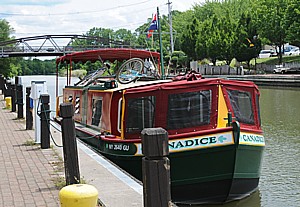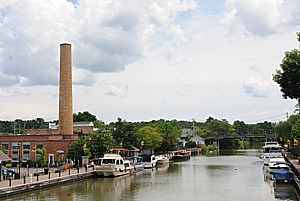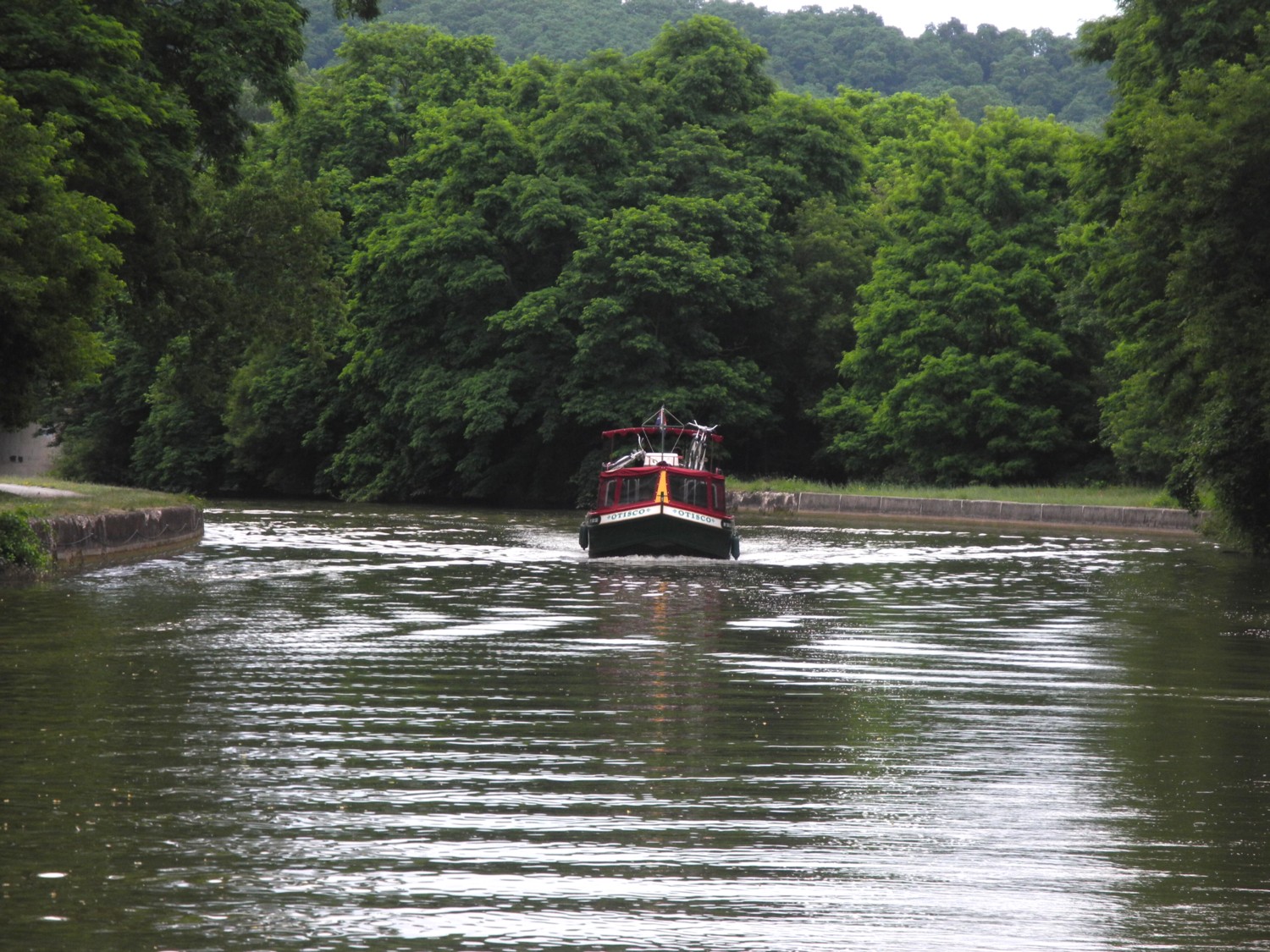
The Otisco, one of Mid-Lakes Navigation’s Lockmasters, traveling on the Erie Canal © 2013 Karen Rubin/news-photos-features.com.
Fairport and Pittsford are Jewels Among Canal Towns
by Karen Rubin
The Grand Canyon may be a natural wonder, but the Erie Canal is a marvel of human industry and ingenuity.
We are experiencing the Erie Canal by canalboat, a floating home, really, specially designed for the Erie Canal but based on the English canalboats that Peter Wiles, who operated, by Mid-Lakes Navigation, a tourboat company on Lake Skaneateles, had seen.
At the time, the canal was being “transitioned” from commercial traffic to recreational use – boating, canoeing, kayaking, crewing.
All along our travels, as we boat and bike from town to town, we have been fascinated by historical markers with explanations, historic photos of the construction and of the people and businesses that developed along the canal. The story seems to unfold.
And so we learn that the canal evolved over time, and is still evolving.
In the early 19th century, countering mammoth opposition, New York State Governor DeWitt Clinton got the Legislature to allocate $7 million (the equivalent of $7 billion today) to build the 363-mile long Erie Canal, which opened in 1825.
“The canal became the most successful and influential artificial waterway in North America. It connected the Hudson River at Albany with Lake Erie at Buffalo, establishing the first all-water link between the Atlantic seaboard and the Great Lakes.
“More than just a heroic feat of engineering, the Erie Canal opened the interior of the continent, providing a safe and reliable route for westbound migrants and manufactured goods, and eastbound products of forests, farms, and mines. Connecting places, people and ideas, it strengthened the nation and fostered social and reform movements.”
The Erie Canal was designated the Erie Canalway National Heritage Corridor by Congress in 2000.
All of this unfolds for us as we travel along the canal on the Canadice. More interestingly, is how seeing history first-hand resonates in how we understand and deal with the challenges of today.
Fairport
After just under two hours of boating from Macedon, where we started out on our self-skippered Lockmaster canalboat, we come to the first town we will visit: Fairport.
Theoretically, I need to jump off at just the precise moment with the line and tie the bow before the boat pulls away from the dock. It’s my first time and I am nervous. but just in the knick, someone helps us tie up at the dock (one of the pleasures of this style of travel, there are usually people to help or advise you) – a man who has spent a year on a houseboat traveling on the Erie Canal through the Great Lakes to the Mississippi down to the Gulf of Mexico to the west coast of Florida, and up the eastern coast to the Hudson River and back onto the Canal; I am in awe. He gives us some pointers on handling our canalboat (piloting the boat on the calm waters of the canal is not the problem – it is only docking and going through locks that you need to get the knack of).
Fairport is a most charming town, with shops and restaurants right along the canal. It is a picture-perfect model of revitalization.
Fairport did not exist before construction of the Erie Canal dried up a swamp and produced a “fair port” for travelers. “Commerce thrived as entrepreneurs turned ideas into products,” says one of the best guides to this portion of the canal, “100 Must See Miles”
One of these products was Henry Deland’s idea to produce baking soda from wood ash. The building right on the canal and next to the bridge, where there is now a delightful Towpath Cafe, one of the more delightful eateries along the canal (live music, too), and the offices of an engineering and landscape architectural firm, once was where Deland manufactured baking soda which was transported by canal to international markets.
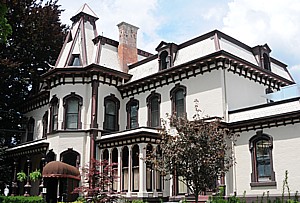
The Deland Mansion in Fairport. Henry Deland made his fortune producing baking soda in a factory beside the Erie Canal and shipping it via the canal to markets © 2013 Karen Rubin/news-photos-features.com.
Just up Main Street, on the south side of the canal, I find the Green Lantern Inn, which was the Deland Mansion, built in 1876. Deland has a Florida connection: after he made his fortune in Fairport, he bought land and founded Deland, Florida, in 1876, where he envisioned creating a citrus, agricultural and tourism center. He sold his northern business and hired people to clear land, lay out streets, erect buildings and recruit settlers, most of whom came from upstate New York; then he lost his fortune in an orange freeze in 1885.
The mansion is magnificent: Second Empire style with tower, porches, fireplaces, it was one of the grandest private residences in western New York. After several private owners, including the Clark Family, the Deland Mansion opened as the Green Lantern Inn sometime after 1928, and served as a restaurant, speakeasy, rooming house, banquet hall.
The mansion is across from the First Baptist Church, which was built at same time as Deland built his mansion. The Deland family donated its windows and paid more than one-third of construction cost, but stipulated that the door of church and door of mansion be directly across (now there is a small building in front of the mansion that obstructs; building is for sale).
Each of the canal towns has done a superb job of using historical markers and photos to illustrate the “then and now.” As we follow them, it is like a story that unfolds.
At Fairport, there is a marker that shows how Old South Main Street “yields to urban renewal: Commercial block changes from necessities to niceties.”
There is also a plaque honoring Peter Wiles, Sarah and Peter’s father, for his leadership in developing the Erie Canal for recreational purposes.
On the north side of the canal, passed the railroad tracks, where freight trains rumble through frequently during the day, we find a shuttered factory still waiting to be “repurposed.”
The beauty of the canal boat is that you can organize the day around what you want to do – whether it is to just hang out in a town – perhaps visit a museum. Our main purpose is to position us to bike the towpath. And so we tie up the Canadice at Fairport, take down our bikes from the roof, and head out about 7 miles to the next major town, Pittsford, along the canal bikeway. It is one of the prettier rides, with lovely homes on the canal.
We pass Perinton Park, a beautiful community park where there are tennis courts and is a lovely place to picnic.
Just before Pittsford, we cross over a mile-long section called “The Great Embankment.” This is the highest canal embankment, actually built over the Irondequoit Creek which rushes through a tunnel under the canal.
In the earliest days of the Erie Canal, the embankment thrilled both onlookers and passengers as boats seemed to travel in midair over the mile-wide valley created by the Irondequoit Creek. The canal has been rebuilt three times since it originally opened in 1823. The original canal was a mere four-feet deep and 40-feet wide; three times it was enlarged, made deeper (first 7 feet deep and 70-feet wide, then 12-feet deep and 120-feet wide), and in many cases, moved entirely to make a better route as boats became motorized.
This is our first introduction to the engineering of the Erie Canal. I really hadn’t even thought of the canal as having a false bottom, that the canal is actually drained (around November 1), and refilled (around May 1) each season.
The Great Embankment is a revelation, but we will find even more dramatic examples of engineering, as we explore by bike and boat.
We return to Fairport, and prepare to get underway again – actually boating back to Pittsford.
It’s just passed 6 pm when we leave Fairport.
But to leave Fairport, you have to go under a lift bridge, and Fairport’s is very distinctive: it is constructed with no right angles.
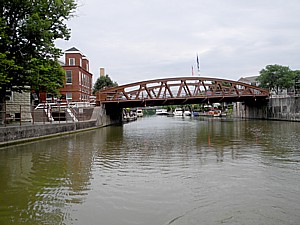
One of the thrills of cruising the Erie Canal is going under the lift-bridges. Fairport’s is particularly interesting: it has: no right angles© 2013 Karen Rubin/news-photos-features.com.
There are 16 lift bridges on the Erie Canal, all of them in the west, and the eastern-most one is here at Fairport. The bridges are delights to look at – they have ornate towers and it is wonderful to watch how they work. (A site provides locations and information about the locks and lift bridges, www.100megsfree3.com/wordsmith/statistics.html).
Matt has instructed us on the etiquette of using the radio to ask the operator to lift a bridge or open a lock. Some of the bridges are covered by operators handling multiple bridges, so you might be told to standby and wait for the operator to get back to the bridge.
The operator tells us we will have to wait a few minutes.
For the most part, we are lucky on our trip, there is not a lot of traffic so we are never stacked up. The operators also ask where you are headed so they alert the operators ahead. I figure out to call as we get near a bridge or lock, to get an idea of how fast or slow to approach.
It is just before 8 pm when we dock at Pittsford– I jump off with the line.
Pittsford
We tie up for the night at the newly refurbished Port of Pittsford Park, right below the Main Street Bridge (there is no charge; some of the ports along the canal charge up to $15 to overnight).
By this time, it is nearly 9 pm on a Sunday and though Pittsford has some of the best selection in restaurants near the canal that we find of any of the towns, just about everything shuts down by 8:30 pm.
We stroll the charming streets (and there are some gorgeous residential streets as well), and see what an affluent community Pittsford is – like Great Neck is to Manhattan. It is loaded with doctors, engineers and professionals. Old money, and new money poured in over the last 15 years to revitalize the downtown area.
Pittsford was settled in 1789 by Revolutionary War veterans, but it was the Erie Canal that first brought prosperity to the town, because it facilitated transport to market of tons of heavy gravel from the nearby hills.
We see stunning Victorian-era buildings – the Phoenix Hotel, built in 1812 in the Federalist style, 1812 to serve the Erie Canal and Turnpike trade, restored 1967 (now an office building which houses the Institute 4 Priority Thinking, offering Leadership Coaching, Organizational Development, and Ethics Education; across from the Town Hall, dated 1890. There is also the Canal Lamp Inn, a stunning Victorian, right beside the canal bridge. (Self-guided walk through Pittsford, villageofpittsford.org).
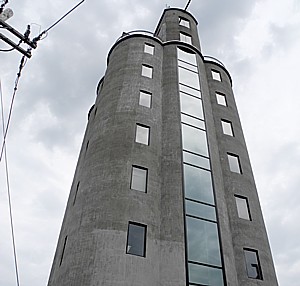
Pittsford’s Flour Mill has been repurposed into an office tower© 2013 Karen Rubin/news-photos-features.com.
Pittsford offers some of the best examples of a town that has “repurposed” from its industrial heritage: the silo for the Pittsford Flour Mill has been converted to an office tower; the Coal Tower has become a restaurant’ Towpath Bike Rental shop was a hardware store. There is still a shuttered barn and factory which adds character to the waterfront.
At this late hour, we are guided by a resident to Pontillo’s Pizza Place and bring our slices back to the canalpark to dine on a picnic table beside our boat.
We watch ducks that appear to be doing elaborate synchronized swim in the canal, when they believe no one is around to watch.
Staying overnight in the canalside park where we are docked (it is closed to all but the boaters after 10 pm), the setting is magical.
Just minutes after we finish our picnic dinner, get inside our boat and close the hatches, it starts to pour. We are cozy inside. We hear the patter of rain as we watch a DVD on our computer.
It’s been a day of adventure and discovery, as perfect as can be.
The star attraction – and a major character – in this travel epic is the Erie Canal, itself. The historic markers we come upon are like chapters in the story, and as our trip unfolds, our appreciation of what the canal was, what it represented, and the impact it had, grows.
The Erie Canal journey by boat and bike continues..
Helpful contacts:
Mid-Lakes Navigation, 11 Jordan St, PO Box 61, skaneateles, NY 13152, 315-685-8500, 800-545-4318, www.midlakesnav.com.
Erie Canalway National Heritage Corridor, PO Box 219, Waterford, NY 12188, 518-237-8643, ext 3110, www.eriecanalway.org.
See also:
Journey by boat and bike along the Erie Canal: Macedon-Fairport-Pittsford and slideshow
Erie Canal journey by boat, bike: Exploring canaltowns from Pittsford to Albion and slideshow
Erie Canal journey: Albion-Medina bikeride is most scenic, illuminating and slideshow
Erie Canal journey by boat and bike: Palmyra, ‘Queen of Canal Towns’ and slideshow
New season of self-skippered canalboat cruises on New York’s historic Erie Canal (Photos)
______________________
© 2013 Travel Features Syndicate, a division of Workstyles, Inc. All rights reserved. Visit www.examiner.com/eclectic-travel-in-national/karen-rubin, www.examiner.com/eclectic-traveler-in-long-island/karen-rubin, www.examiner.com/international-travel-in-national/karen-rubin and travelwritersmagazine.com/TravelFeaturesSyndicate. Blogging at goingplacesnearandfar.wordpress.com. Send comments or questions to FamTravLtr@aol.com. Tweet @TravelFeatures. ‘Like’ us at facebook.com/NewsPhotoFeatures.

